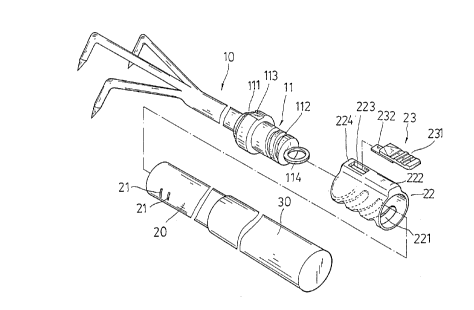Some of the information on this Web page has been provided by external sources. The Government of Canada is not responsible for the accuracy, reliability or currency of the information supplied by external sources. Users wishing to rely upon this information should consult directly with the source of the information. Content provided by external sources is not subject to official languages, privacy and accessibility requirements.
Any discrepancies in the text and image of the Claims and Abstract are due to differing posting times. Text of the Claims and Abstract are posted:
| (12) Patent: | (11) CA 2186537 |
|---|---|
| (54) English Title: | TOOL HANDLE MOUNTING STRUCTURE FOR GARDEN TOOLS |
| (54) French Title: | DISPOSITIF DE MONTAGE POUR ARTICLES DE JARDIN |
| Status: | Deemed expired |
| (51) International Patent Classification (IPC): |
|
|---|---|
| (72) Inventors : |
|
| (73) Owners : |
|
| (71) Applicants : |
|
| (74) Agent: | KIRBY EADES GALE BAKER |
| (74) Associate agent: | |
| (45) Issued: | 1999-08-31 |
| (22) Filed Date: | 1996-09-26 |
| (41) Open to Public Inspection: | 1998-03-27 |
| Examination requested: | 1996-09-26 |
| Availability of licence: | N/A |
| (25) Language of filing: | English |
| Patent Cooperation Treaty (PCT): | No |
|---|
| (30) Application Priority Data: | None |
|---|
A tool handle mounting structure
including a tool head having a fixed coupling cap,
a handle having a tubular front end fastened to the
coupling cap by a screw joint, and a sleeve fixedly
mounted around the tubular front end to hold a
sliding lock, wherein when the sliding lock is
moved forwards after the handle is coupled to the
coupling cap of the tool head, the handle is
locked; when the sliding lock is moved backwards,
the handle is unlocked, and can be turned reversely
and disconnected from the coupling cap of the tool
head.
Cette invention concerne une monture de manche d'outil composée d'une tête d'outil à capuchon d'accouplement fixe, d'un manche à extrémité frontale tubulaire assujetti au capuchon de d'accouplement par vissage et d'un manchon fixe autour de ladite extrémité frontale tubulaire servant de support à un verrou coulissant. Ce verrou est poussé vers l'avant après vissage du manche dans le capuchon d'accouplement pour verrouiller le manche à la tête d'outil et ramené vers l'arrière pour déverrouiller le manche et permettre de la dévisser du capuchon d'accouplement.
Note: Claims are shown in the official language in which they were submitted.
Note: Descriptions are shown in the official language in which they were submitted.

For a clearer understanding of the status of the application/patent presented on this page, the site Disclaimer , as well as the definitions for Patent , Administrative Status , Maintenance Fee and Payment History should be consulted.
| Title | Date |
|---|---|
| Forecasted Issue Date | 1999-08-31 |
| (22) Filed | 1996-09-26 |
| Examination Requested | 1996-09-26 |
| (41) Open to Public Inspection | 1998-03-27 |
| (45) Issued | 1999-08-31 |
| Deemed Expired | 2002-09-26 |
There is no abandonment history.
| Fee Type | Anniversary Year | Due Date | Amount Paid | Paid Date |
|---|---|---|---|---|
| Application Fee | $0.00 | 1996-09-26 | ||
| Maintenance Fee - Application - New Act | 2 | 1998-09-28 | $50.00 | 1998-07-27 |
| Final Fee | $150.00 | 1999-05-27 | ||
| Maintenance Fee - Application - New Act | 3 | 1999-09-27 | $50.00 | 1999-08-11 |
| Maintenance Fee - Patent - New Act | 4 | 2000-09-26 | $50.00 | 2000-07-26 |
Note: Records showing the ownership history in alphabetical order.
| Current Owners on Record |
|---|
| HSU, CHUN-LI |
| Past Owners on Record |
|---|
| None |